Research Report: Swinburne University WIL Awareness and Perceptions
VerifiedAdded on 2022/09/05
|16
|3408
|18
Report
AI Summary
This report presents a research proposal focused on the awareness and perceptions of Swinburne University stakeholders regarding the introduction of Work Integrated Learning (WIL) programs, including professional placements and internships. It addresses the marketing problem of increasing student participation in WIL and investigates the level of awareness, attitudes, and communication preferences of undergraduate students. The research utilizes secondary data analysis, drawing from peer-reviewed articles to explore student factors influencing WIL program awareness and acceptance. The methodology includes a descriptive investigation approach to analyze data. The report also considers ethical issues and limitations of the proposal. The study aims to identify strategies to enhance WIL program awareness and student engagement. This report will be useful to anyone looking to understand the challenges associated with introducing new programs in educational settings, and provides a detailed analysis of the factors influencing the success of WIL initiatives.
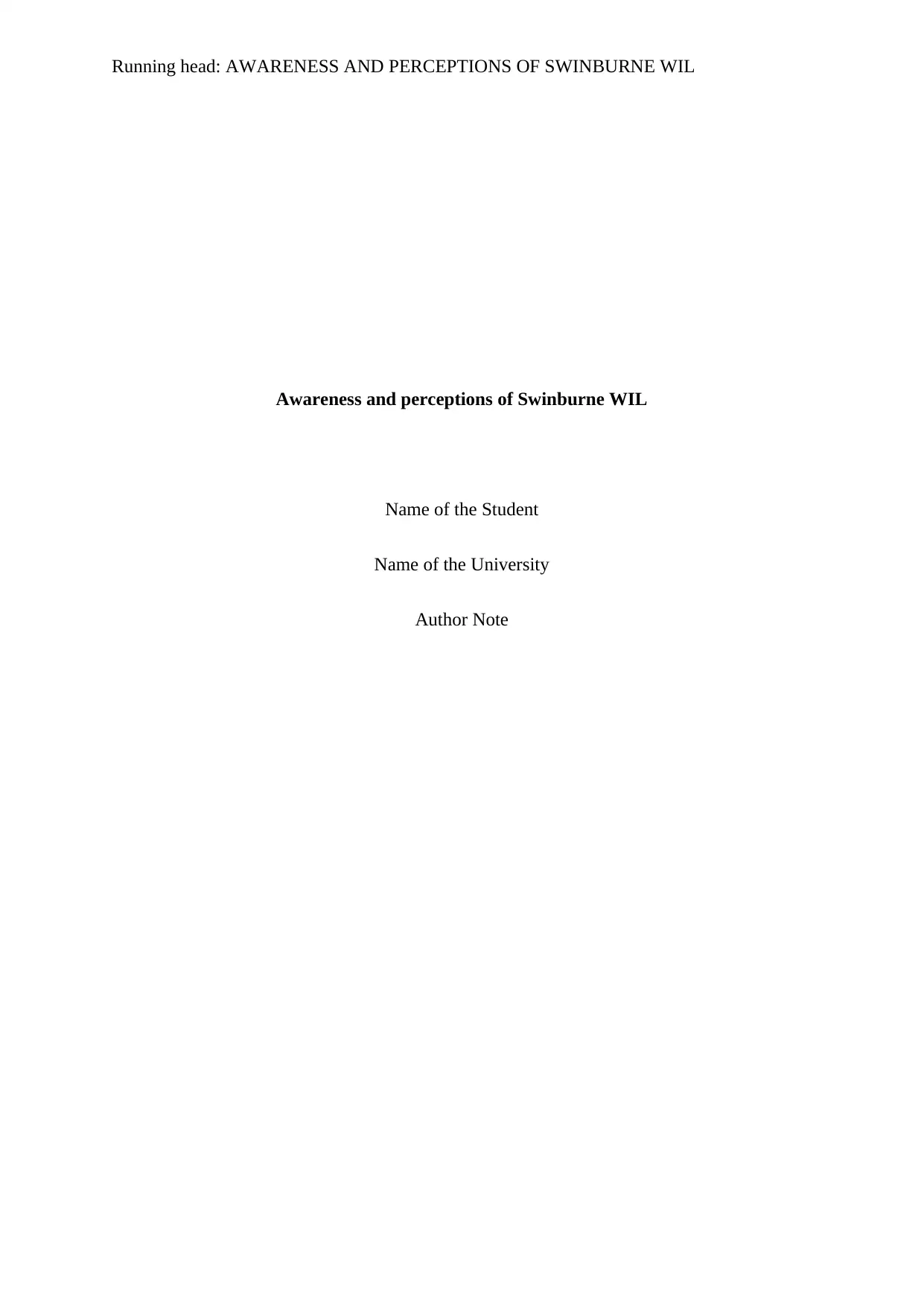
Running head: AWARENESS AND PERCEPTIONS OF SWINBURNE WIL
Awareness and perceptions of Swinburne WIL
Name of the Student
Name of the University
Author Note
Awareness and perceptions of Swinburne WIL
Name of the Student
Name of the University
Author Note
Paraphrase This Document
Need a fresh take? Get an instant paraphrase of this document with our AI Paraphraser
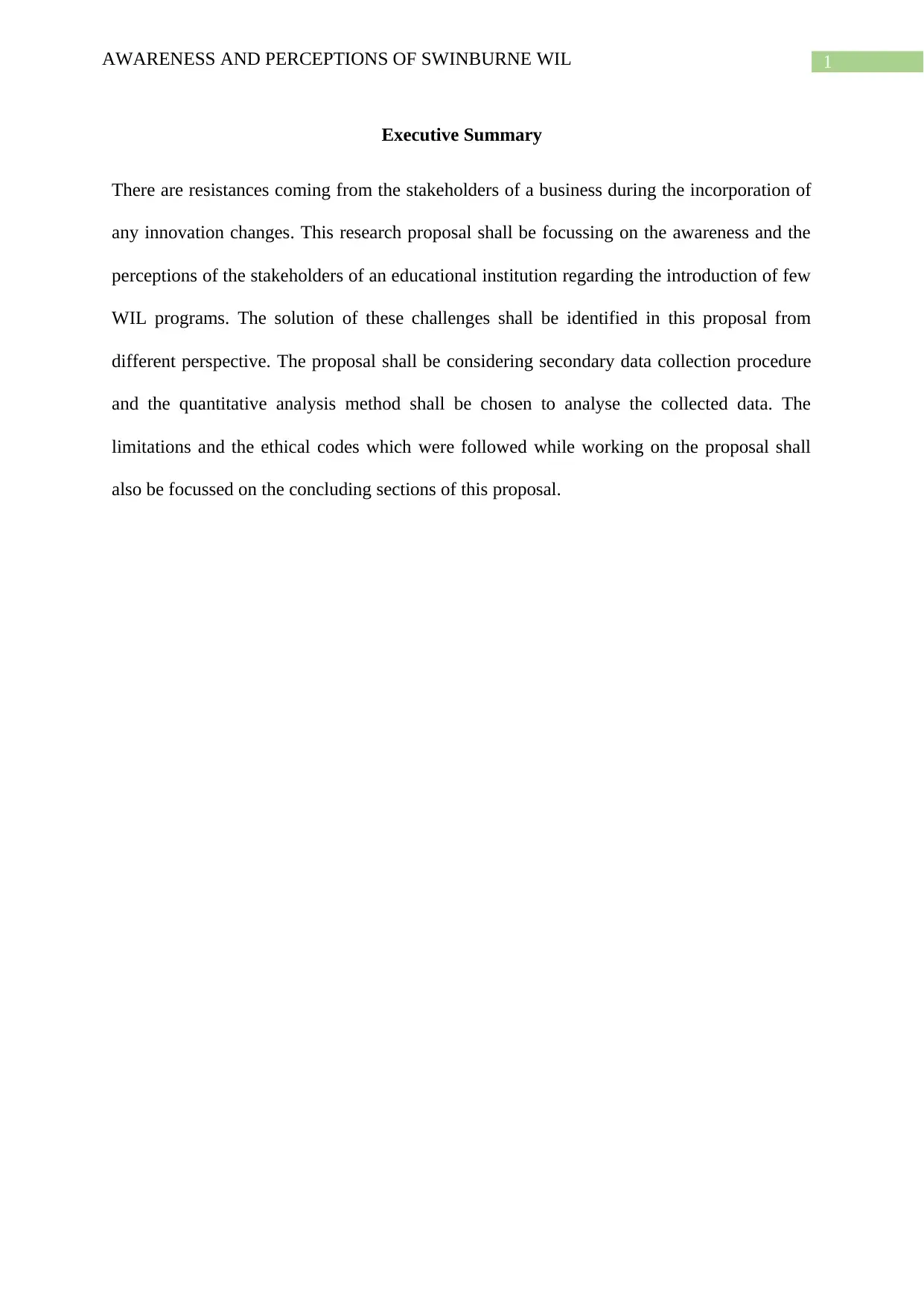
1AWARENESS AND PERCEPTIONS OF SWINBURNE WIL
Executive Summary
There are resistances coming from the stakeholders of a business during the incorporation of
any innovation changes. This research proposal shall be focussing on the awareness and the
perceptions of the stakeholders of an educational institution regarding the introduction of few
WIL programs. The solution of these challenges shall be identified in this proposal from
different perspective. The proposal shall be considering secondary data collection procedure
and the quantitative analysis method shall be chosen to analyse the collected data. The
limitations and the ethical codes which were followed while working on the proposal shall
also be focussed on the concluding sections of this proposal.
Executive Summary
There are resistances coming from the stakeholders of a business during the incorporation of
any innovation changes. This research proposal shall be focussing on the awareness and the
perceptions of the stakeholders of an educational institution regarding the introduction of few
WIL programs. The solution of these challenges shall be identified in this proposal from
different perspective. The proposal shall be considering secondary data collection procedure
and the quantitative analysis method shall be chosen to analyse the collected data. The
limitations and the ethical codes which were followed while working on the proposal shall
also be focussed on the concluding sections of this proposal.
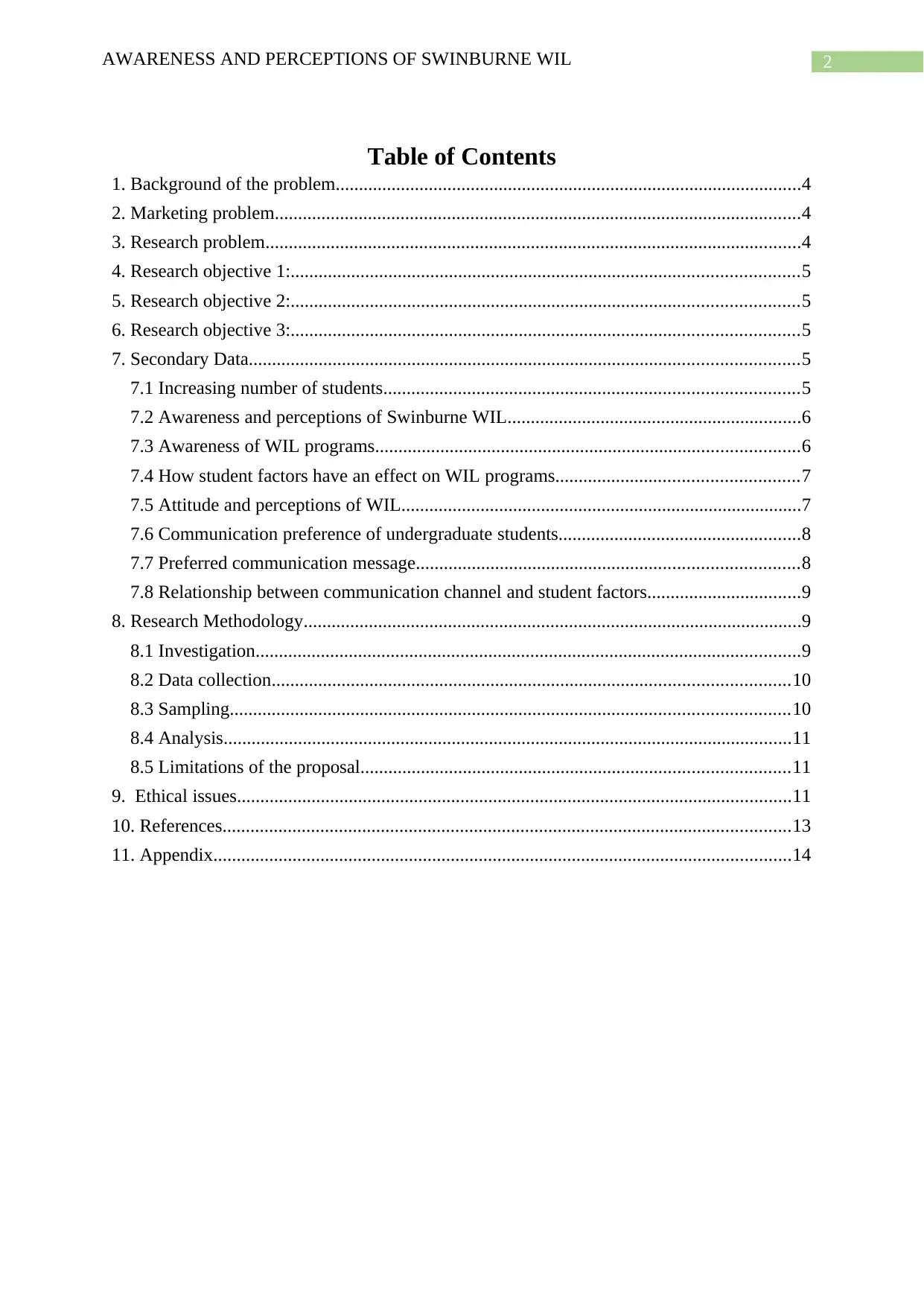
2AWARENESS AND PERCEPTIONS OF SWINBURNE WIL
Table of Contents
1. Background of the problem....................................................................................................4
2. Marketing problem.................................................................................................................4
3. Research problem...................................................................................................................4
4. Research objective 1:.............................................................................................................5
5. Research objective 2:.............................................................................................................5
6. Research objective 3:.............................................................................................................5
7. Secondary Data......................................................................................................................5
7.1 Increasing number of students.........................................................................................5
7.2 Awareness and perceptions of Swinburne WIL...............................................................6
7.3 Awareness of WIL programs...........................................................................................6
7.4 How student factors have an effect on WIL programs....................................................7
7.5 Attitude and perceptions of WIL......................................................................................7
7.6 Communication preference of undergraduate students....................................................8
7.7 Preferred communication message..................................................................................8
7.8 Relationship between communication channel and student factors.................................9
8. Research Methodology...........................................................................................................9
8.1 Investigation.....................................................................................................................9
8.2 Data collection...............................................................................................................10
8.3 Sampling........................................................................................................................10
8.4 Analysis..........................................................................................................................11
8.5 Limitations of the proposal............................................................................................11
9. Ethical issues.......................................................................................................................11
10. References..........................................................................................................................13
11. Appendix............................................................................................................................14
Table of Contents
1. Background of the problem....................................................................................................4
2. Marketing problem.................................................................................................................4
3. Research problem...................................................................................................................4
4. Research objective 1:.............................................................................................................5
5. Research objective 2:.............................................................................................................5
6. Research objective 3:.............................................................................................................5
7. Secondary Data......................................................................................................................5
7.1 Increasing number of students.........................................................................................5
7.2 Awareness and perceptions of Swinburne WIL...............................................................6
7.3 Awareness of WIL programs...........................................................................................6
7.4 How student factors have an effect on WIL programs....................................................7
7.5 Attitude and perceptions of WIL......................................................................................7
7.6 Communication preference of undergraduate students....................................................8
7.7 Preferred communication message..................................................................................8
7.8 Relationship between communication channel and student factors.................................9
8. Research Methodology...........................................................................................................9
8.1 Investigation.....................................................................................................................9
8.2 Data collection...............................................................................................................10
8.3 Sampling........................................................................................................................10
8.4 Analysis..........................................................................................................................11
8.5 Limitations of the proposal............................................................................................11
9. Ethical issues.......................................................................................................................11
10. References..........................................................................................................................13
11. Appendix............................................................................................................................14
⊘ This is a preview!⊘
Do you want full access?
Subscribe today to unlock all pages.

Trusted by 1+ million students worldwide
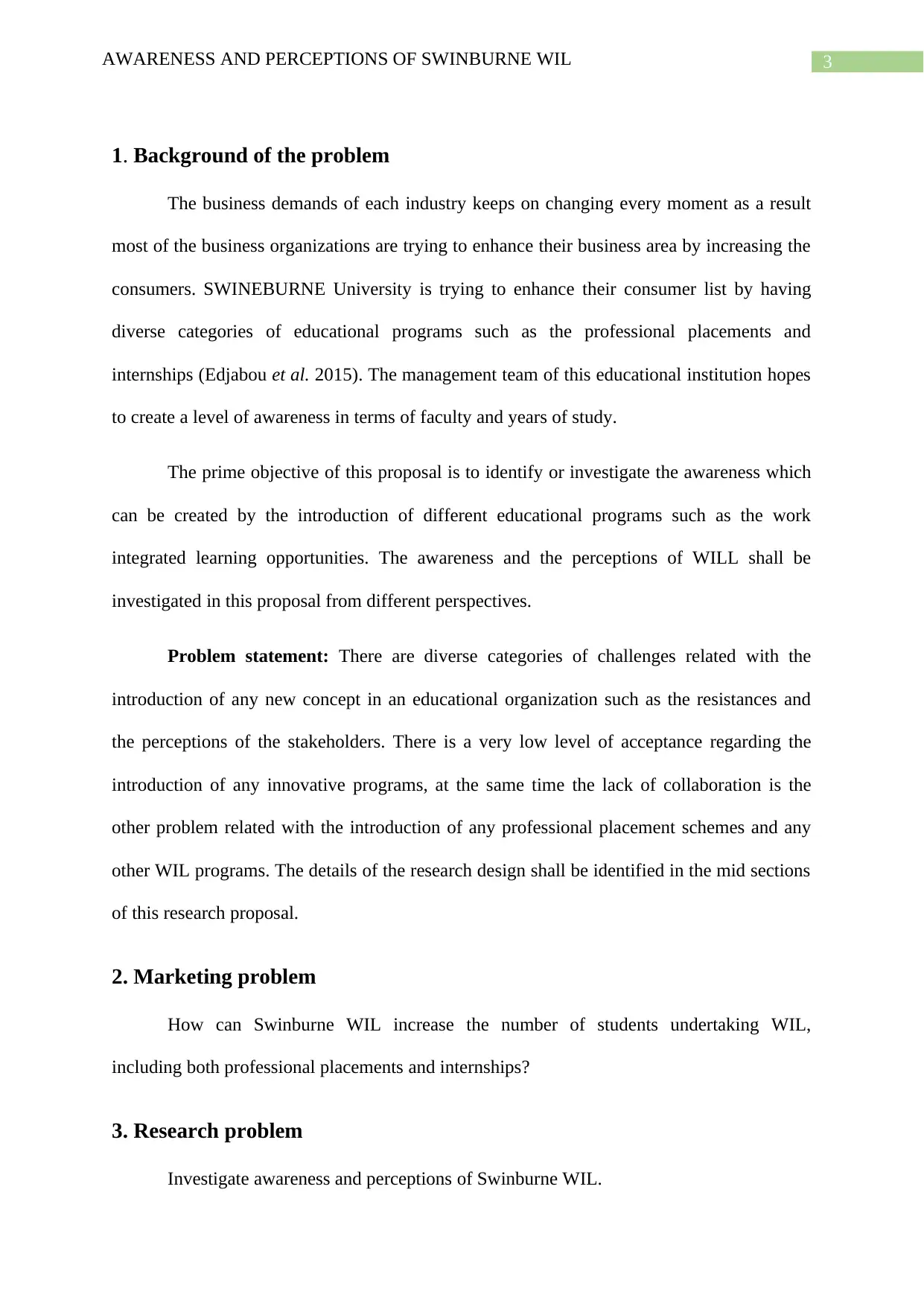
3AWARENESS AND PERCEPTIONS OF SWINBURNE WIL
1. Background of the problem
The business demands of each industry keeps on changing every moment as a result
most of the business organizations are trying to enhance their business area by increasing the
consumers. SWINEBURNE University is trying to enhance their consumer list by having
diverse categories of educational programs such as the professional placements and
internships (Edjabou et al. 2015). The management team of this educational institution hopes
to create a level of awareness in terms of faculty and years of study.
The prime objective of this proposal is to identify or investigate the awareness which
can be created by the introduction of different educational programs such as the work
integrated learning opportunities. The awareness and the perceptions of WILL shall be
investigated in this proposal from different perspectives.
Problem statement: There are diverse categories of challenges related with the
introduction of any new concept in an educational organization such as the resistances and
the perceptions of the stakeholders. There is a very low level of acceptance regarding the
introduction of any innovative programs, at the same time the lack of collaboration is the
other problem related with the introduction of any professional placement schemes and any
other WIL programs. The details of the research design shall be identified in the mid sections
of this research proposal.
2. Marketing problem
How can Swinburne WIL increase the number of students undertaking WIL,
including both professional placements and internships?
3. Research problem
Investigate awareness and perceptions of Swinburne WIL.
1. Background of the problem
The business demands of each industry keeps on changing every moment as a result
most of the business organizations are trying to enhance their business area by increasing the
consumers. SWINEBURNE University is trying to enhance their consumer list by having
diverse categories of educational programs such as the professional placements and
internships (Edjabou et al. 2015). The management team of this educational institution hopes
to create a level of awareness in terms of faculty and years of study.
The prime objective of this proposal is to identify or investigate the awareness which
can be created by the introduction of different educational programs such as the work
integrated learning opportunities. The awareness and the perceptions of WILL shall be
investigated in this proposal from different perspectives.
Problem statement: There are diverse categories of challenges related with the
introduction of any new concept in an educational organization such as the resistances and
the perceptions of the stakeholders. There is a very low level of acceptance regarding the
introduction of any innovative programs, at the same time the lack of collaboration is the
other problem related with the introduction of any professional placement schemes and any
other WIL programs. The details of the research design shall be identified in the mid sections
of this research proposal.
2. Marketing problem
How can Swinburne WIL increase the number of students undertaking WIL,
including both professional placements and internships?
3. Research problem
Investigate awareness and perceptions of Swinburne WIL.
Paraphrase This Document
Need a fresh take? Get an instant paraphrase of this document with our AI Paraphraser
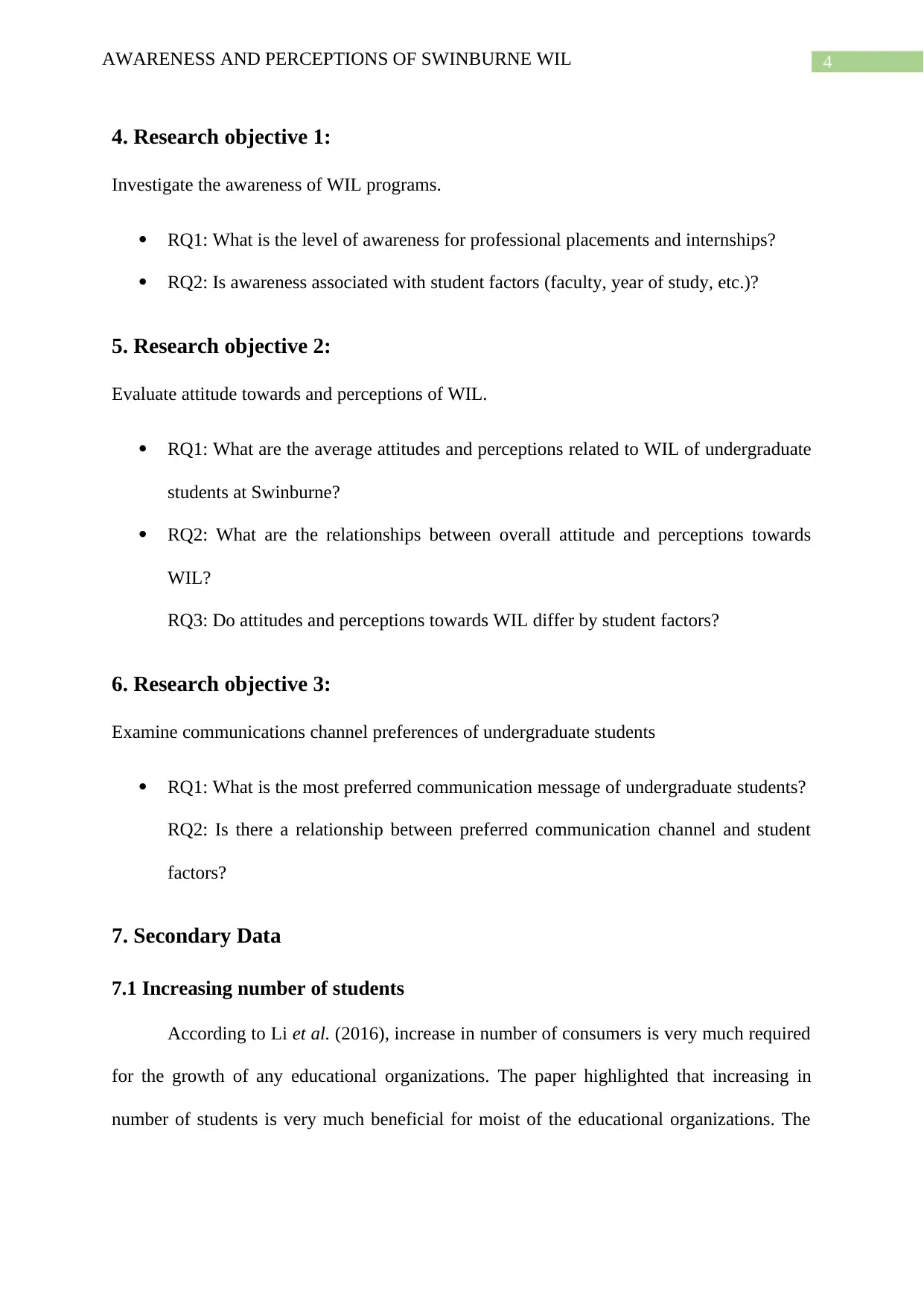
4AWARENESS AND PERCEPTIONS OF SWINBURNE WIL
4. Research objective 1:
Investigate the awareness of WIL programs.
RQ1: What is the level of awareness for professional placements and internships?
RQ2: Is awareness associated with student factors (faculty, year of study, etc.)?
5. Research objective 2:
Evaluate attitude towards and perceptions of WIL.
RQ1: What are the average attitudes and perceptions related to WIL of undergraduate
students at Swinburne?
RQ2: What are the relationships between overall attitude and perceptions towards
WIL?
RQ3: Do attitudes and perceptions towards WIL differ by student factors?
6. Research objective 3:
Examine communications channel preferences of undergraduate students
RQ1: What is the most preferred communication message of undergraduate students?
RQ2: Is there a relationship between preferred communication channel and student
factors?
7. Secondary Data
7.1 Increasing number of students
According to Li et al. (2016), increase in number of consumers is very much required
for the growth of any educational organizations. The paper highlighted that increasing in
number of students is very much beneficial for moist of the educational organizations. The
4. Research objective 1:
Investigate the awareness of WIL programs.
RQ1: What is the level of awareness for professional placements and internships?
RQ2: Is awareness associated with student factors (faculty, year of study, etc.)?
5. Research objective 2:
Evaluate attitude towards and perceptions of WIL.
RQ1: What are the average attitudes and perceptions related to WIL of undergraduate
students at Swinburne?
RQ2: What are the relationships between overall attitude and perceptions towards
WIL?
RQ3: Do attitudes and perceptions towards WIL differ by student factors?
6. Research objective 3:
Examine communications channel preferences of undergraduate students
RQ1: What is the most preferred communication message of undergraduate students?
RQ2: Is there a relationship between preferred communication channel and student
factors?
7. Secondary Data
7.1 Increasing number of students
According to Li et al. (2016), increase in number of consumers is very much required
for the growth of any educational organizations. The paper highlighted that increasing in
number of students is very much beneficial for moist of the educational organizations. The
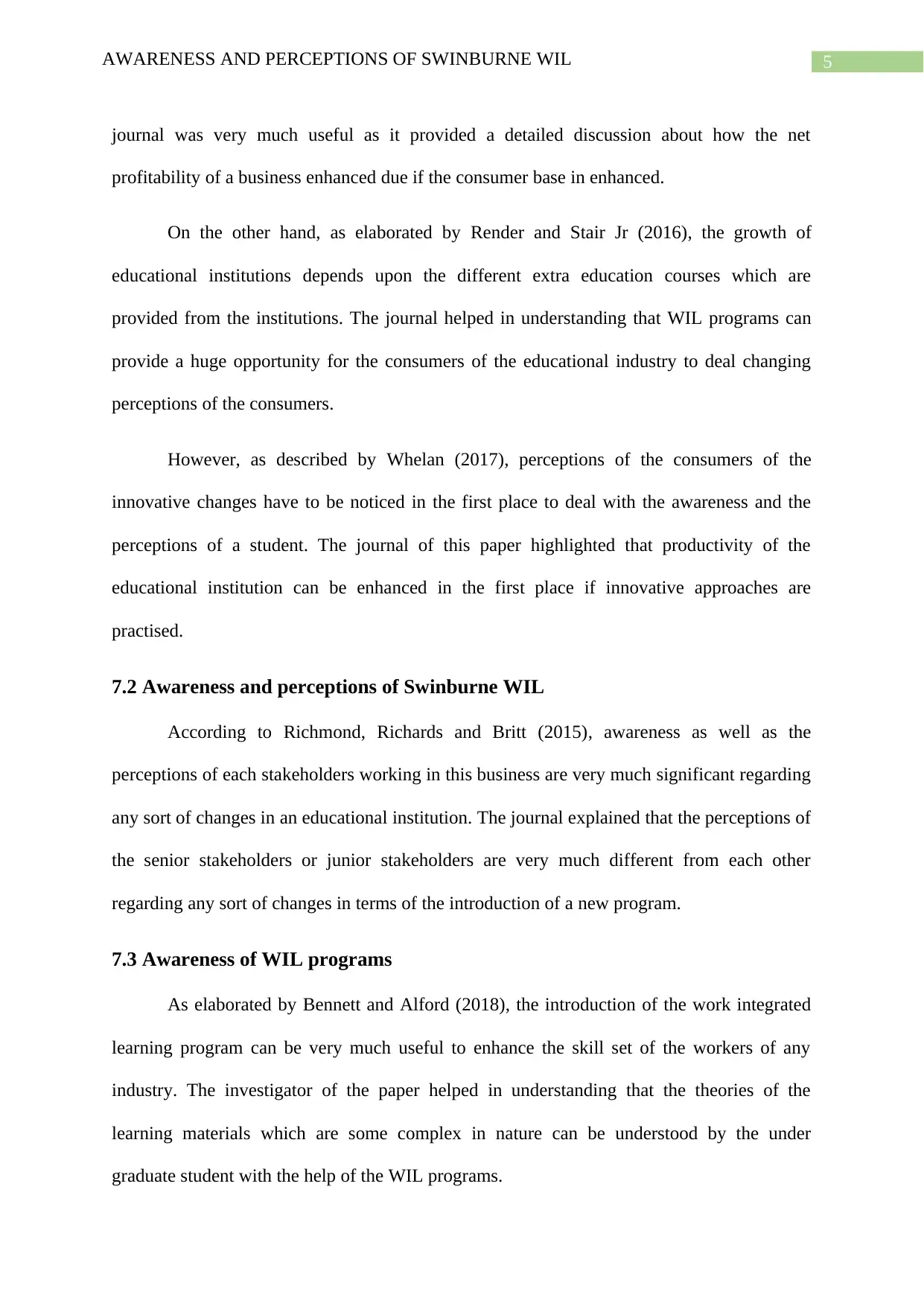
5AWARENESS AND PERCEPTIONS OF SWINBURNE WIL
journal was very much useful as it provided a detailed discussion about how the net
profitability of a business enhanced due if the consumer base in enhanced.
On the other hand, as elaborated by Render and Stair Jr (2016), the growth of
educational institutions depends upon the different extra education courses which are
provided from the institutions. The journal helped in understanding that WIL programs can
provide a huge opportunity for the consumers of the educational industry to deal changing
perceptions of the consumers.
However, as described by Whelan (2017), perceptions of the consumers of the
innovative changes have to be noticed in the first place to deal with the awareness and the
perceptions of a student. The journal of this paper highlighted that productivity of the
educational institution can be enhanced in the first place if innovative approaches are
practised.
7.2 Awareness and perceptions of Swinburne WIL
According to Richmond, Richards and Britt (2015), awareness as well as the
perceptions of each stakeholders working in this business are very much significant regarding
any sort of changes in an educational institution. The journal explained that the perceptions of
the senior stakeholders or junior stakeholders are very much different from each other
regarding any sort of changes in terms of the introduction of a new program.
7.3 Awareness of WIL programs
As elaborated by Bennett and Alford (2018), the introduction of the work integrated
learning program can be very much useful to enhance the skill set of the workers of any
industry. The investigator of the paper helped in understanding that the theories of the
learning materials which are some complex in nature can be understood by the under
graduate student with the help of the WIL programs.
journal was very much useful as it provided a detailed discussion about how the net
profitability of a business enhanced due if the consumer base in enhanced.
On the other hand, as elaborated by Render and Stair Jr (2016), the growth of
educational institutions depends upon the different extra education courses which are
provided from the institutions. The journal helped in understanding that WIL programs can
provide a huge opportunity for the consumers of the educational industry to deal changing
perceptions of the consumers.
However, as described by Whelan (2017), perceptions of the consumers of the
innovative changes have to be noticed in the first place to deal with the awareness and the
perceptions of a student. The journal of this paper highlighted that productivity of the
educational institution can be enhanced in the first place if innovative approaches are
practised.
7.2 Awareness and perceptions of Swinburne WIL
According to Richmond, Richards and Britt (2015), awareness as well as the
perceptions of each stakeholders working in this business are very much significant regarding
any sort of changes in an educational institution. The journal explained that the perceptions of
the senior stakeholders or junior stakeholders are very much different from each other
regarding any sort of changes in terms of the introduction of a new program.
7.3 Awareness of WIL programs
As elaborated by Bennett and Alford (2018), the introduction of the work integrated
learning program can be very much useful to enhance the skill set of the workers of any
industry. The investigator of the paper helped in understanding that the theories of the
learning materials which are some complex in nature can be understood by the under
graduate student with the help of the WIL programs.
⊘ This is a preview!⊘
Do you want full access?
Subscribe today to unlock all pages.

Trusted by 1+ million students worldwide
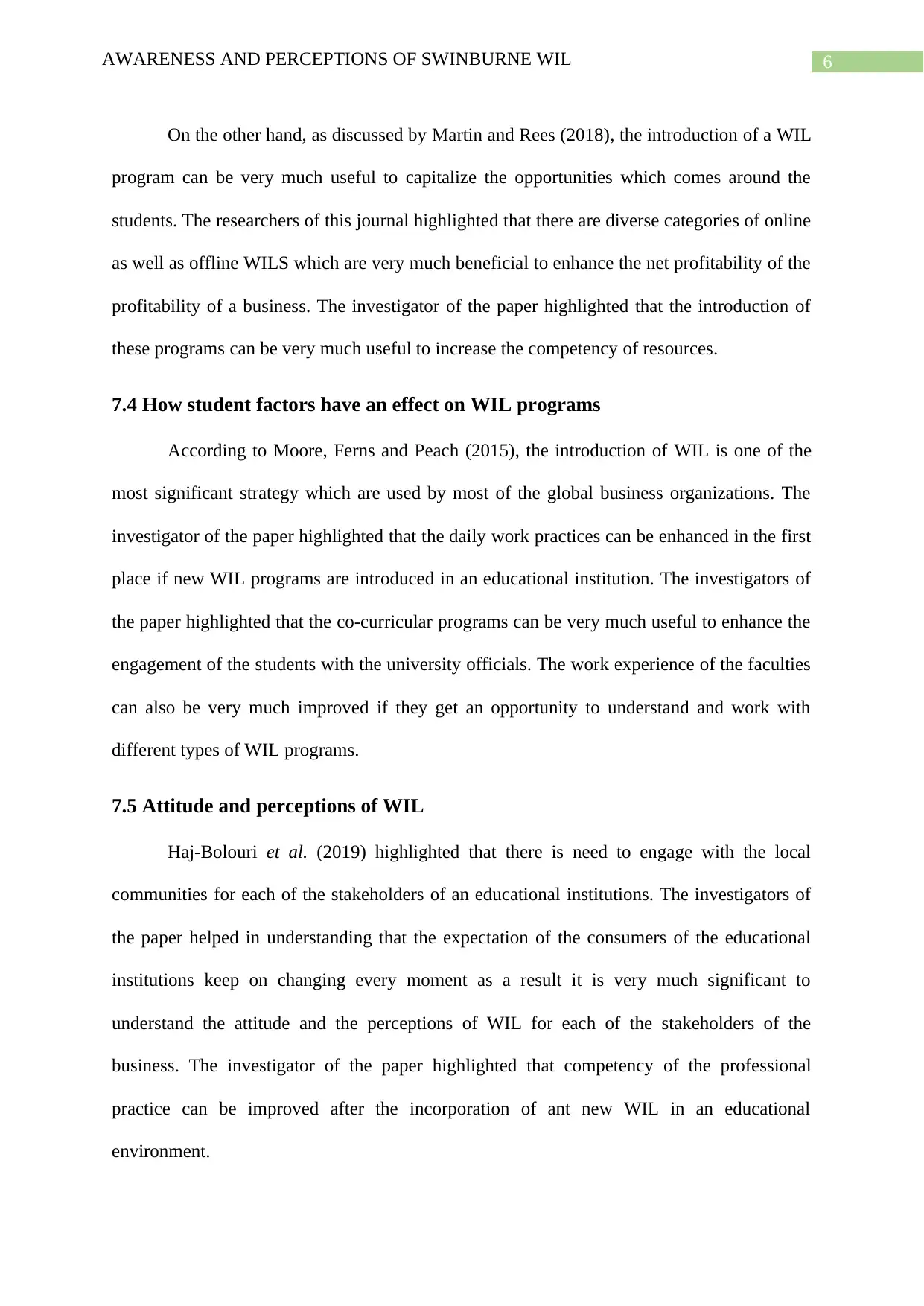
6AWARENESS AND PERCEPTIONS OF SWINBURNE WIL
On the other hand, as discussed by Martin and Rees (2018), the introduction of a WIL
program can be very much useful to capitalize the opportunities which comes around the
students. The researchers of this journal highlighted that there are diverse categories of online
as well as offline WILS which are very much beneficial to enhance the net profitability of the
profitability of a business. The investigator of the paper highlighted that the introduction of
these programs can be very much useful to increase the competency of resources.
7.4 How student factors have an effect on WIL programs
According to Moore, Ferns and Peach (2015), the introduction of WIL is one of the
most significant strategy which are used by most of the global business organizations. The
investigator of the paper highlighted that the daily work practices can be enhanced in the first
place if new WIL programs are introduced in an educational institution. The investigators of
the paper highlighted that the co-curricular programs can be very much useful to enhance the
engagement of the students with the university officials. The work experience of the faculties
can also be very much improved if they get an opportunity to understand and work with
different types of WIL programs.
7.5 Attitude and perceptions of WIL
Haj-Bolouri et al. (2019) highlighted that there is need to engage with the local
communities for each of the stakeholders of an educational institutions. The investigators of
the paper helped in understanding that the expectation of the consumers of the educational
institutions keep on changing every moment as a result it is very much significant to
understand the attitude and the perceptions of WIL for each of the stakeholders of the
business. The investigator of the paper highlighted that competency of the professional
practice can be improved after the incorporation of ant new WIL in an educational
environment.
On the other hand, as discussed by Martin and Rees (2018), the introduction of a WIL
program can be very much useful to capitalize the opportunities which comes around the
students. The researchers of this journal highlighted that there are diverse categories of online
as well as offline WILS which are very much beneficial to enhance the net profitability of the
profitability of a business. The investigator of the paper highlighted that the introduction of
these programs can be very much useful to increase the competency of resources.
7.4 How student factors have an effect on WIL programs
According to Moore, Ferns and Peach (2015), the introduction of WIL is one of the
most significant strategy which are used by most of the global business organizations. The
investigator of the paper highlighted that the daily work practices can be enhanced in the first
place if new WIL programs are introduced in an educational institution. The investigators of
the paper highlighted that the co-curricular programs can be very much useful to enhance the
engagement of the students with the university officials. The work experience of the faculties
can also be very much improved if they get an opportunity to understand and work with
different types of WIL programs.
7.5 Attitude and perceptions of WIL
Haj-Bolouri et al. (2019) highlighted that there is need to engage with the local
communities for each of the stakeholders of an educational institutions. The investigators of
the paper helped in understanding that the expectation of the consumers of the educational
institutions keep on changing every moment as a result it is very much significant to
understand the attitude and the perceptions of WIL for each of the stakeholders of the
business. The investigator of the paper highlighted that competency of the professional
practice can be improved after the incorporation of ant new WIL in an educational
environment.
Paraphrase This Document
Need a fresh take? Get an instant paraphrase of this document with our AI Paraphraser
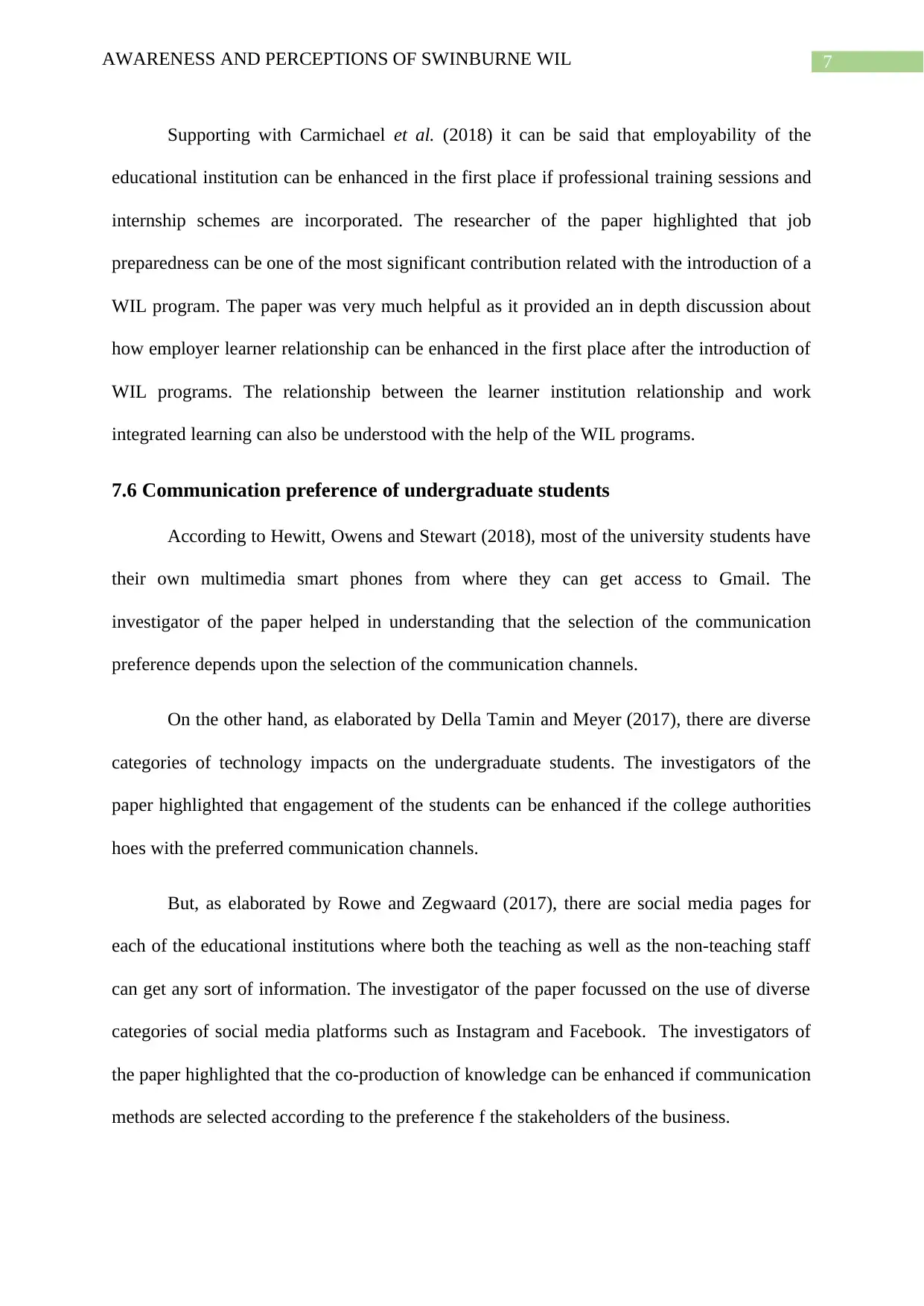
7AWARENESS AND PERCEPTIONS OF SWINBURNE WIL
Supporting with Carmichael et al. (2018) it can be said that employability of the
educational institution can be enhanced in the first place if professional training sessions and
internship schemes are incorporated. The researcher of the paper highlighted that job
preparedness can be one of the most significant contribution related with the introduction of a
WIL program. The paper was very much helpful as it provided an in depth discussion about
how employer learner relationship can be enhanced in the first place after the introduction of
WIL programs. The relationship between the learner institution relationship and work
integrated learning can also be understood with the help of the WIL programs.
7.6 Communication preference of undergraduate students
According to Hewitt, Owens and Stewart (2018), most of the university students have
their own multimedia smart phones from where they can get access to Gmail. The
investigator of the paper helped in understanding that the selection of the communication
preference depends upon the selection of the communication channels.
On the other hand, as elaborated by Della Tamin and Meyer (2017), there are diverse
categories of technology impacts on the undergraduate students. The investigators of the
paper highlighted that engagement of the students can be enhanced if the college authorities
hoes with the preferred communication channels.
But, as elaborated by Rowe and Zegwaard (2017), there are social media pages for
each of the educational institutions where both the teaching as well as the non-teaching staff
can get any sort of information. The investigator of the paper focussed on the use of diverse
categories of social media platforms such as Instagram and Facebook. The investigators of
the paper highlighted that the co-production of knowledge can be enhanced if communication
methods are selected according to the preference f the stakeholders of the business.
Supporting with Carmichael et al. (2018) it can be said that employability of the
educational institution can be enhanced in the first place if professional training sessions and
internship schemes are incorporated. The researcher of the paper highlighted that job
preparedness can be one of the most significant contribution related with the introduction of a
WIL program. The paper was very much helpful as it provided an in depth discussion about
how employer learner relationship can be enhanced in the first place after the introduction of
WIL programs. The relationship between the learner institution relationship and work
integrated learning can also be understood with the help of the WIL programs.
7.6 Communication preference of undergraduate students
According to Hewitt, Owens and Stewart (2018), most of the university students have
their own multimedia smart phones from where they can get access to Gmail. The
investigator of the paper helped in understanding that the selection of the communication
preference depends upon the selection of the communication channels.
On the other hand, as elaborated by Della Tamin and Meyer (2017), there are diverse
categories of technology impacts on the undergraduate students. The investigators of the
paper highlighted that engagement of the students can be enhanced if the college authorities
hoes with the preferred communication channels.
But, as elaborated by Rowe and Zegwaard (2017), there are social media pages for
each of the educational institutions where both the teaching as well as the non-teaching staff
can get any sort of information. The investigator of the paper focussed on the use of diverse
categories of social media platforms such as Instagram and Facebook. The investigators of
the paper highlighted that the co-production of knowledge can be enhanced if communication
methods are selected according to the preference f the stakeholders of the business.
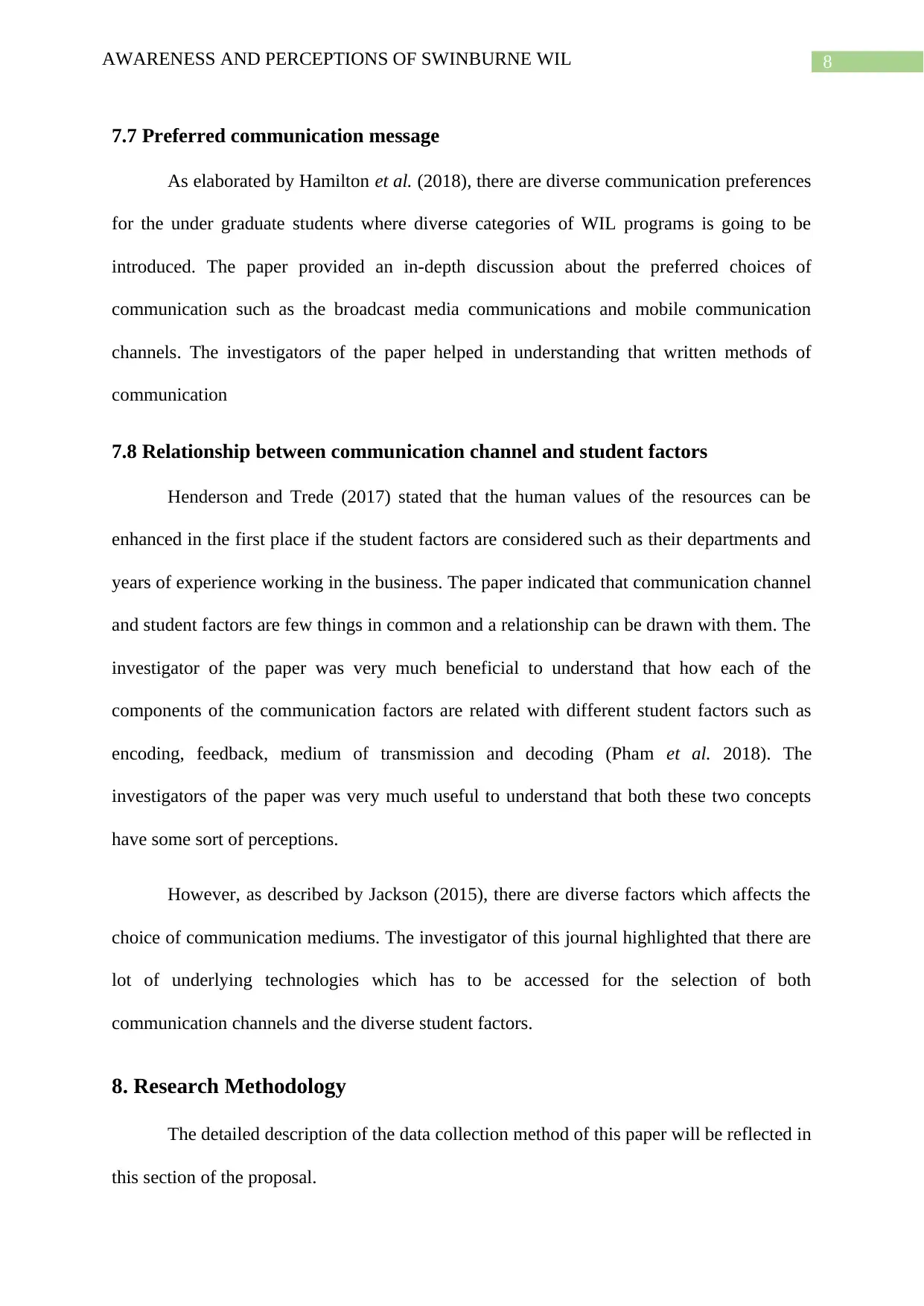
8AWARENESS AND PERCEPTIONS OF SWINBURNE WIL
7.7 Preferred communication message
As elaborated by Hamilton et al. (2018), there are diverse communication preferences
for the under graduate students where diverse categories of WIL programs is going to be
introduced. The paper provided an in-depth discussion about the preferred choices of
communication such as the broadcast media communications and mobile communication
channels. The investigators of the paper helped in understanding that written methods of
communication
7.8 Relationship between communication channel and student factors
Henderson and Trede (2017) stated that the human values of the resources can be
enhanced in the first place if the student factors are considered such as their departments and
years of experience working in the business. The paper indicated that communication channel
and student factors are few things in common and a relationship can be drawn with them. The
investigator of the paper was very much beneficial to understand that how each of the
components of the communication factors are related with different student factors such as
encoding, feedback, medium of transmission and decoding (Pham et al. 2018). The
investigators of the paper was very much useful to understand that both these two concepts
have some sort of perceptions.
However, as described by Jackson (2015), there are diverse factors which affects the
choice of communication mediums. The investigator of this journal highlighted that there are
lot of underlying technologies which has to be accessed for the selection of both
communication channels and the diverse student factors.
8. Research Methodology
The detailed description of the data collection method of this paper will be reflected in
this section of the proposal.
7.7 Preferred communication message
As elaborated by Hamilton et al. (2018), there are diverse communication preferences
for the under graduate students where diverse categories of WIL programs is going to be
introduced. The paper provided an in-depth discussion about the preferred choices of
communication such as the broadcast media communications and mobile communication
channels. The investigators of the paper helped in understanding that written methods of
communication
7.8 Relationship between communication channel and student factors
Henderson and Trede (2017) stated that the human values of the resources can be
enhanced in the first place if the student factors are considered such as their departments and
years of experience working in the business. The paper indicated that communication channel
and student factors are few things in common and a relationship can be drawn with them. The
investigator of the paper was very much beneficial to understand that how each of the
components of the communication factors are related with different student factors such as
encoding, feedback, medium of transmission and decoding (Pham et al. 2018). The
investigators of the paper was very much useful to understand that both these two concepts
have some sort of perceptions.
However, as described by Jackson (2015), there are diverse factors which affects the
choice of communication mediums. The investigator of this journal highlighted that there are
lot of underlying technologies which has to be accessed for the selection of both
communication channels and the diverse student factors.
8. Research Methodology
The detailed description of the data collection method of this paper will be reflected in
this section of the proposal.
⊘ This is a preview!⊘
Do you want full access?
Subscribe today to unlock all pages.

Trusted by 1+ million students worldwide
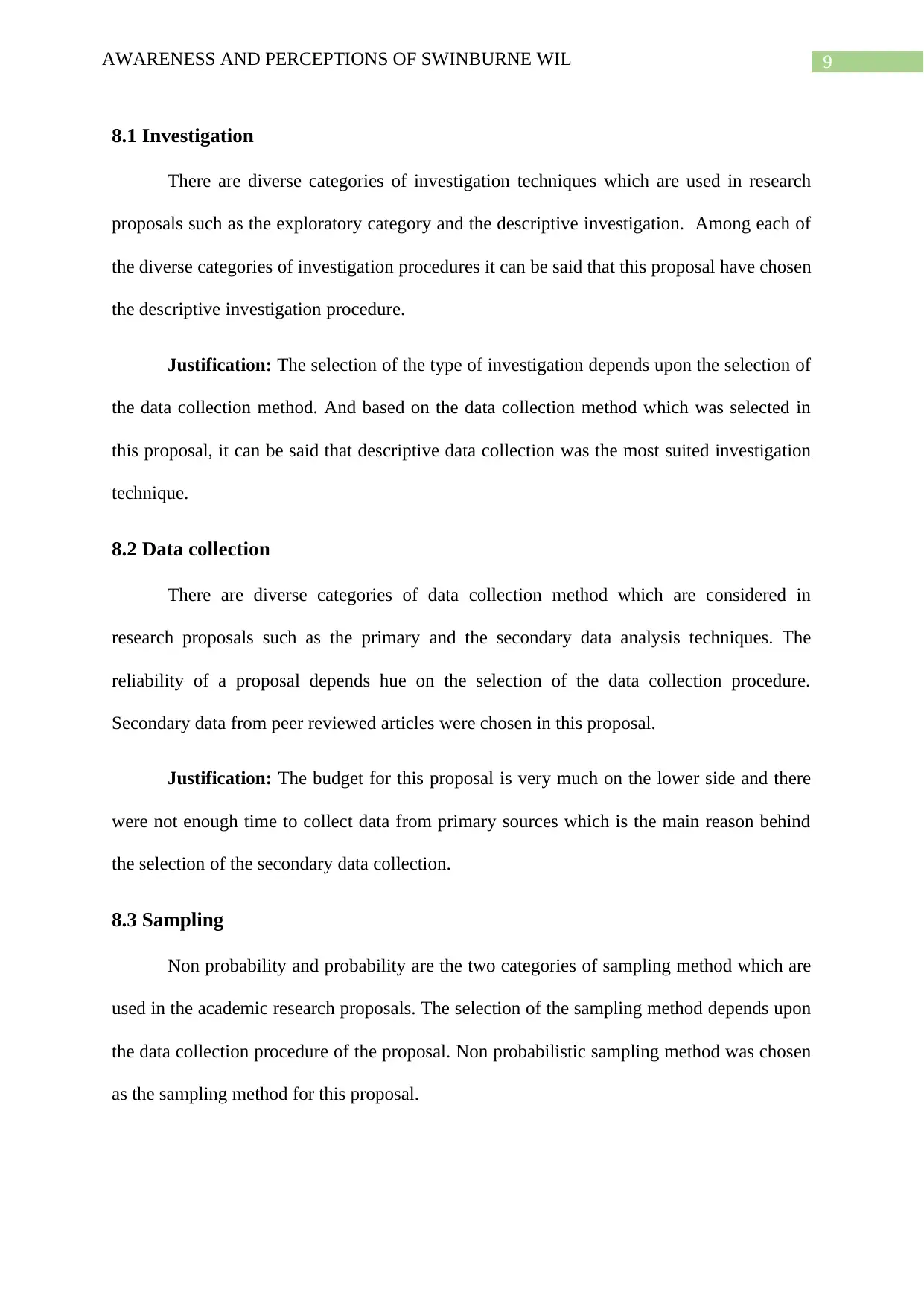
9AWARENESS AND PERCEPTIONS OF SWINBURNE WIL
8.1 Investigation
There are diverse categories of investigation techniques which are used in research
proposals such as the exploratory category and the descriptive investigation. Among each of
the diverse categories of investigation procedures it can be said that this proposal have chosen
the descriptive investigation procedure.
Justification: The selection of the type of investigation depends upon the selection of
the data collection method. And based on the data collection method which was selected in
this proposal, it can be said that descriptive data collection was the most suited investigation
technique.
8.2 Data collection
There are diverse categories of data collection method which are considered in
research proposals such as the primary and the secondary data analysis techniques. The
reliability of a proposal depends hue on the selection of the data collection procedure.
Secondary data from peer reviewed articles were chosen in this proposal.
Justification: The budget for this proposal is very much on the lower side and there
were not enough time to collect data from primary sources which is the main reason behind
the selection of the secondary data collection.
8.3 Sampling
Non probability and probability are the two categories of sampling method which are
used in the academic research proposals. The selection of the sampling method depends upon
the data collection procedure of the proposal. Non probabilistic sampling method was chosen
as the sampling method for this proposal.
8.1 Investigation
There are diverse categories of investigation techniques which are used in research
proposals such as the exploratory category and the descriptive investigation. Among each of
the diverse categories of investigation procedures it can be said that this proposal have chosen
the descriptive investigation procedure.
Justification: The selection of the type of investigation depends upon the selection of
the data collection method. And based on the data collection method which was selected in
this proposal, it can be said that descriptive data collection was the most suited investigation
technique.
8.2 Data collection
There are diverse categories of data collection method which are considered in
research proposals such as the primary and the secondary data analysis techniques. The
reliability of a proposal depends hue on the selection of the data collection procedure.
Secondary data from peer reviewed articles were chosen in this proposal.
Justification: The budget for this proposal is very much on the lower side and there
were not enough time to collect data from primary sources which is the main reason behind
the selection of the secondary data collection.
8.3 Sampling
Non probability and probability are the two categories of sampling method which are
used in the academic research proposals. The selection of the sampling method depends upon
the data collection procedure of the proposal. Non probabilistic sampling method was chosen
as the sampling method for this proposal.
Paraphrase This Document
Need a fresh take? Get an instant paraphrase of this document with our AI Paraphraser
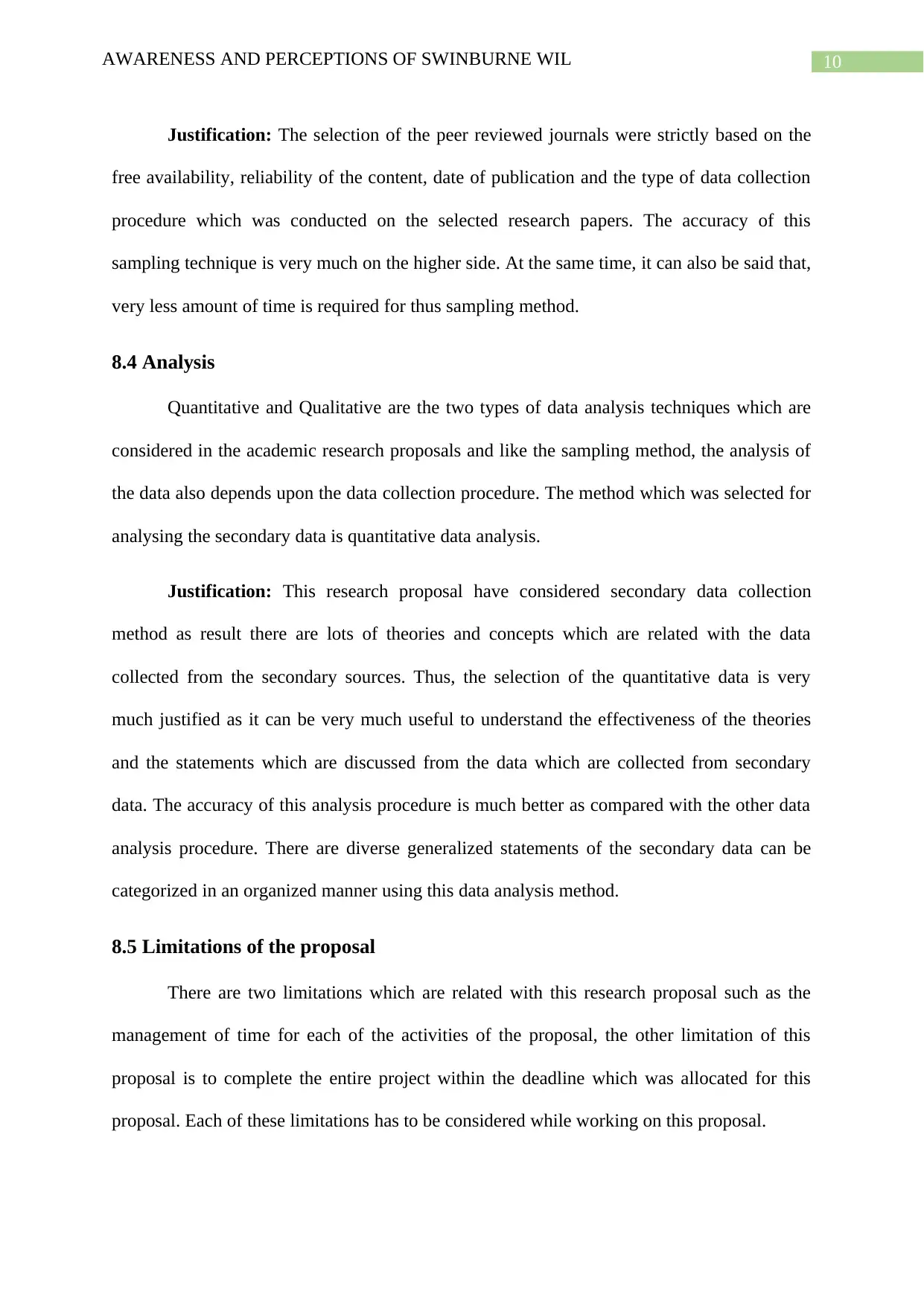
10AWARENESS AND PERCEPTIONS OF SWINBURNE WIL
Justification: The selection of the peer reviewed journals were strictly based on the
free availability, reliability of the content, date of publication and the type of data collection
procedure which was conducted on the selected research papers. The accuracy of this
sampling technique is very much on the higher side. At the same time, it can also be said that,
very less amount of time is required for thus sampling method.
8.4 Analysis
Quantitative and Qualitative are the two types of data analysis techniques which are
considered in the academic research proposals and like the sampling method, the analysis of
the data also depends upon the data collection procedure. The method which was selected for
analysing the secondary data is quantitative data analysis.
Justification: This research proposal have considered secondary data collection
method as result there are lots of theories and concepts which are related with the data
collected from the secondary sources. Thus, the selection of the quantitative data is very
much justified as it can be very much useful to understand the effectiveness of the theories
and the statements which are discussed from the data which are collected from secondary
data. The accuracy of this analysis procedure is much better as compared with the other data
analysis procedure. There are diverse generalized statements of the secondary data can be
categorized in an organized manner using this data analysis method.
8.5 Limitations of the proposal
There are two limitations which are related with this research proposal such as the
management of time for each of the activities of the proposal, the other limitation of this
proposal is to complete the entire project within the deadline which was allocated for this
proposal. Each of these limitations has to be considered while working on this proposal.
Justification: The selection of the peer reviewed journals were strictly based on the
free availability, reliability of the content, date of publication and the type of data collection
procedure which was conducted on the selected research papers. The accuracy of this
sampling technique is very much on the higher side. At the same time, it can also be said that,
very less amount of time is required for thus sampling method.
8.4 Analysis
Quantitative and Qualitative are the two types of data analysis techniques which are
considered in the academic research proposals and like the sampling method, the analysis of
the data also depends upon the data collection procedure. The method which was selected for
analysing the secondary data is quantitative data analysis.
Justification: This research proposal have considered secondary data collection
method as result there are lots of theories and concepts which are related with the data
collected from the secondary sources. Thus, the selection of the quantitative data is very
much justified as it can be very much useful to understand the effectiveness of the theories
and the statements which are discussed from the data which are collected from secondary
data. The accuracy of this analysis procedure is much better as compared with the other data
analysis procedure. There are diverse generalized statements of the secondary data can be
categorized in an organized manner using this data analysis method.
8.5 Limitations of the proposal
There are two limitations which are related with this research proposal such as the
management of time for each of the activities of the proposal, the other limitation of this
proposal is to complete the entire project within the deadline which was allocated for this
proposal. Each of these limitations has to be considered while working on this proposal.
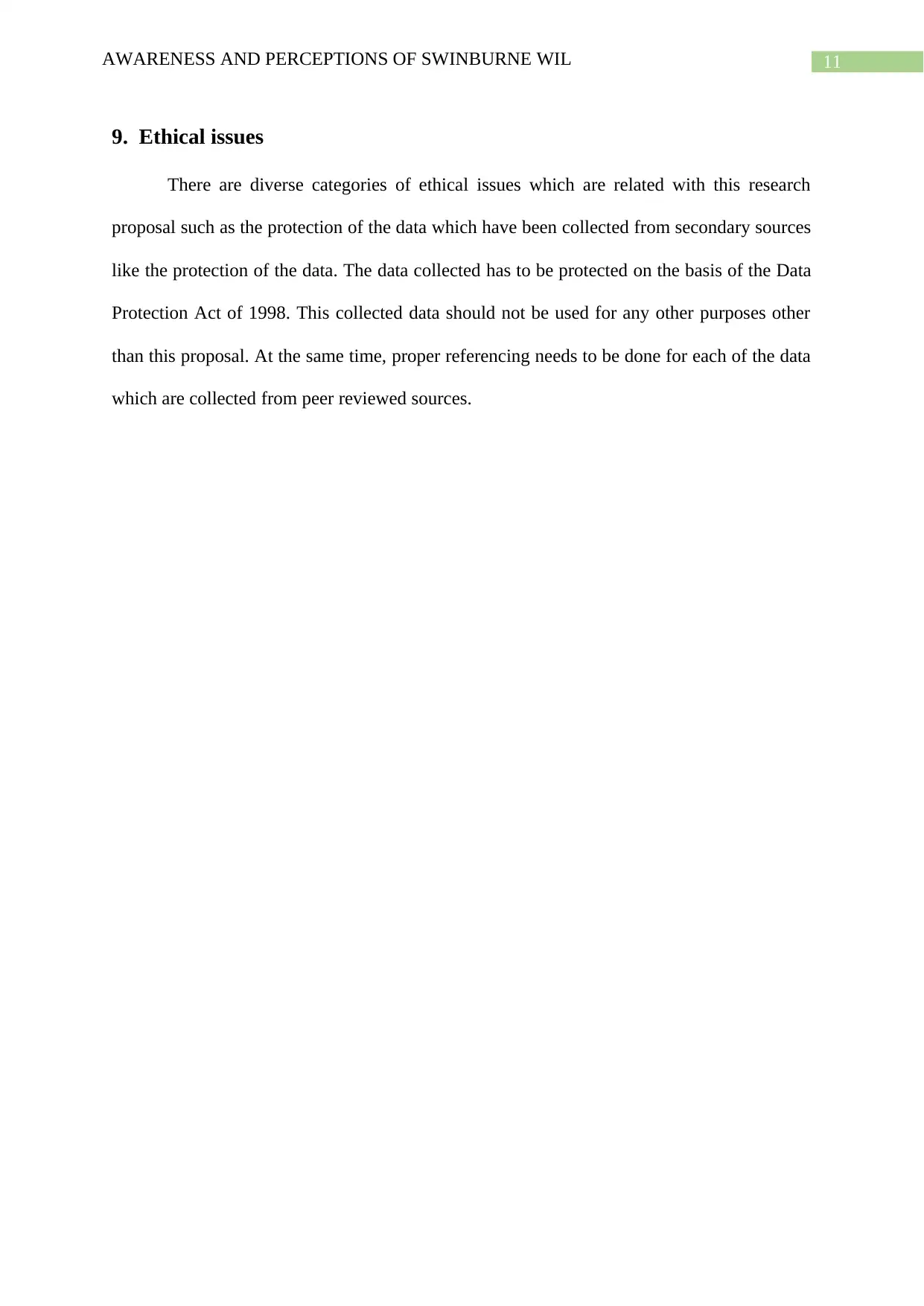
11AWARENESS AND PERCEPTIONS OF SWINBURNE WIL
9. Ethical issues
There are diverse categories of ethical issues which are related with this research
proposal such as the protection of the data which have been collected from secondary sources
like the protection of the data. The data collected has to be protected on the basis of the Data
Protection Act of 1998. This collected data should not be used for any other purposes other
than this proposal. At the same time, proper referencing needs to be done for each of the data
which are collected from peer reviewed sources.
9. Ethical issues
There are diverse categories of ethical issues which are related with this research
proposal such as the protection of the data which have been collected from secondary sources
like the protection of the data. The data collected has to be protected on the basis of the Data
Protection Act of 1998. This collected data should not be used for any other purposes other
than this proposal. At the same time, proper referencing needs to be done for each of the data
which are collected from peer reviewed sources.
⊘ This is a preview!⊘
Do you want full access?
Subscribe today to unlock all pages.

Trusted by 1+ million students worldwide
1 out of 16
Related Documents
Your All-in-One AI-Powered Toolkit for Academic Success.
+13062052269
info@desklib.com
Available 24*7 on WhatsApp / Email
![[object Object]](/_next/static/media/star-bottom.7253800d.svg)
Unlock your academic potential
Copyright © 2020–2025 A2Z Services. All Rights Reserved. Developed and managed by ZUCOL.





